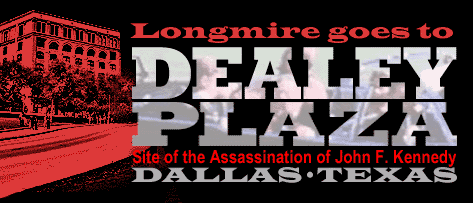
Dallas.
If you're as old as I am (43), or older, the mention of that one word may immediately bring to mind the assassination of President John F. Kennedy on November 22, 1963. I was 4 years old at the time and I personally have no recollection of the events surrounding that day, or the days that followed, other than a very brief image in my mind consisting of watching JFK's funeral on television.
Years ago, I was very interested in the JFK assassination... reading everything I could about the event and the conspiracies that grew from it. That interest subsided over time but I always had, out of curiosity, a desire to visit the site of where it happened. A couple of months ago, I decided to satisfy that curiosity and I made plans to visit Dealey Plaza in Dallas.
I arrived in Dallas on Saturday, March 22. That evening it rained and I was driving around downtown close to sundown, not knowing my way around. I drove down Elm Street and before I realized it, I was actually in Dealey Plaza driving down the road where Kennedy was shot. That was quite an surprise, and shock, to see those all-too familiar images unexpectedly.
The
following photos are from my trip to the site on March 23, 2003...
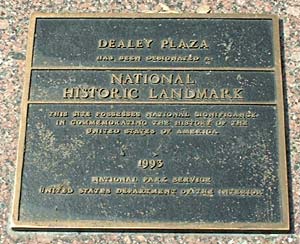
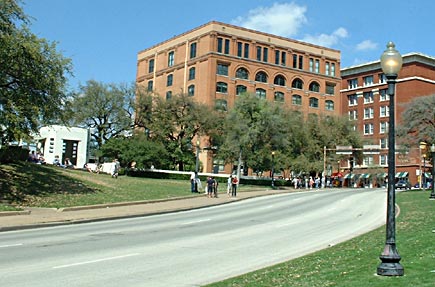
Here is a view of the scene. The road in the foreground is Elm Street. JFK's motorcade traveled down this road as the rifle shots rang out from the Texas School Book Depository, the orange-brick building in the background. The "grassy knoll" is at the left of the photo at the white structure.
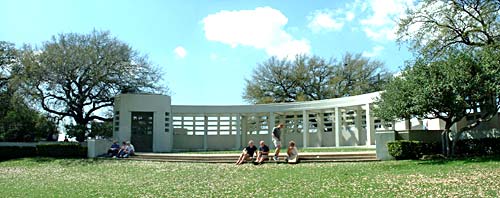
Given the fact of what happened on this site, it's an eerie coincidence that the architectural structures in Dealey Plaza have a similarity to those that you may see in a cemetery.
On
the left side of the "pergola," next to where the group of 3
people are seated, is the wall where Abraham Zapruder shot the famous
"Zapruder film" with his home movie camera.
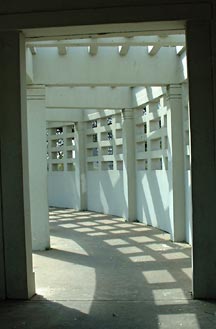
Up
close, these white concrete structures are somewhat crudely made. I was
surprised at the subpar craftsmanship. Perhaps, this plaza and its structures
were not meant to be permanent, but history made it so.
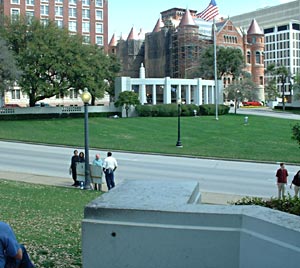
Atop
this short wall is the spot where Zapruder was standing when he filmed
the assassination.
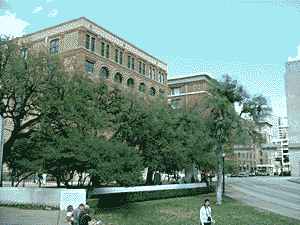
Using photos I took while standing at the Zapruder location, I created an animation to mimic the famous film.
Other
than the now-removed Stemmons Freeway sign that momentarily obscured the
view of the motorcade in the original film, it looks about the same. Weird,
huh?
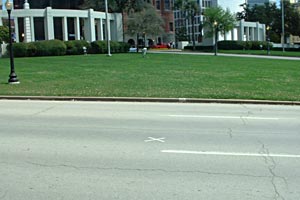
X marks the spot in the road where President Kennedy received the fatal head shot. This is actually marked on the pavement. It's a strange, but fascinating thing to see.
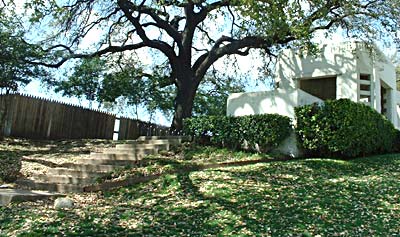
To the left of the white structure is the famous picket fence where many conspiracy theorists believe a second gunman was located.
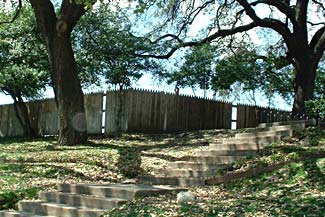
Another
shot of that ominous-looking picket fence.
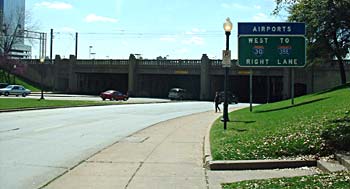
The "triple underpass" is shown here the background, where the motorcade exited Dealey Plaza to rush Kennedy to Parkland Hospital via Stemmons Freeway.
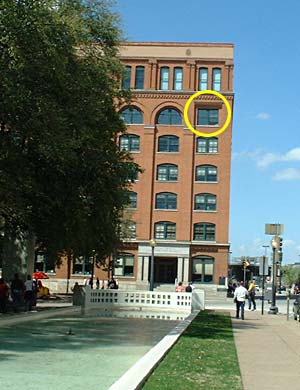
Here's a shot of the Texas School Book Depository building, with reflecting pool in the foreground, as the motorcade faced it driving up Houston Street just before it made a hard left turn onto Elm Street. The window encircled is the sniper's window, of course. I was planning to drive the motorcade's route and videotape it, but you can't do it. Houston Street is a one-way street in the direction away from the building. If it was one-way back in 1963, the motorcade's route was an exception.
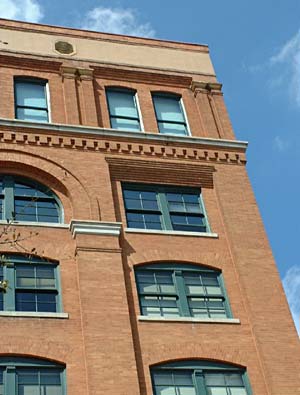
The sniper's window is in a simulated half-open position, to recreate the way it looked on the day of the assassination. The "open" window does have a pane of glass in it to keep out the elements.
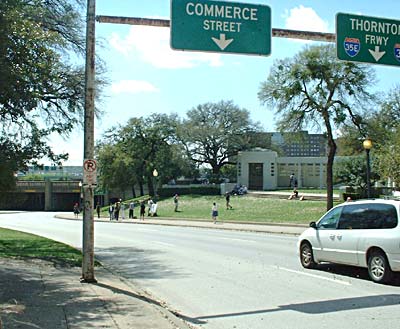
The view of Elm Street and Dealey Plaza if you were making the left turn from Houston Street.
The Sixth Floor Museum
Entry to The Sixth Floor Museum at Dealey Plaza is at the left side of the building. After you pay your $10 admission, you take an elevator ride up to the sixth floor.
Unfortunately, photography isn't allowed inside the museum, so I didn't get any shots of the interior or the view of Dealey Plaza from the windows. The museum's floor is carpeted except for the corner area where the assassin did the deed. That area has a glass partition around it and has the original wood floor showing. They also have replica cardboard boxes arranged at the sniper's window exactly as they were on the day of the assassination. An original police photo near the area verifies this. It's exact, even down to one box being partially open. You cannot enter this area so you can't view the actual scene from that window. But you can look out of the window next to it and just about get the view of JFK's killer's vantage point. To see that in person is a chilling experience to say the least.

Here is the next best thing to actually being able to look out the actual window...a screen shot from the webcam that is installed inside a cardboard box at the sniper's window. The webcam rotates side to side to show Dealey Plaza below.
Near the corner window area is a display case containing the original window/sash from that fateful day, complete with dried flaked paint. The building's owners had it removed shortly after the assassination for fear that it could be damaged if it remained in place.
On the diagonally opposite side of the building is another glass-enclosed area where the assassin's rifle was found. They have recreated the boxes there as well.
Other items in the museum include a collection of the original home movie cameras and still cameras used by the amateur photographers present in Dealey Plaza who captured scenes of the assassination. A replica of the Zapruder camera is displayed as well. There is a scale model of Dealey Plaza on display that the FBI constructed and used during the Warren Commission investigation. There are continuously running documentaries in a mini-theater as well as a television monitor that shows TV news coverage of the events, including the live television shooting of Oswald by Jack Ruby. Lining the walls are displays and photos concerning John F. Kennedy's life as well as an exhibit called "Who Did It?" which deals with the question of conspiracies. The museum doesn't necessarily name Lee Harvey Oswald as Kennedy's killer.
Brand spanking new (started March 21) was an Andy Warhol exhibit containing works of art he created concerning First Lady Jackie Kennedy. In one part of the exhibit was a room that displayed images of the event while you heard voices spoken in monk-like chants with words that you might read off an old news wire teletype machine concerning the assassination. Very weird.
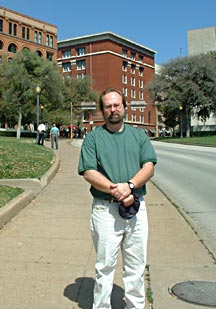
Of course, no trip is valid unless you have photographic proof that you were actually there. Behold, the obligatory pose. I look like I'm about to ask everyone to bow their heads in prayer.
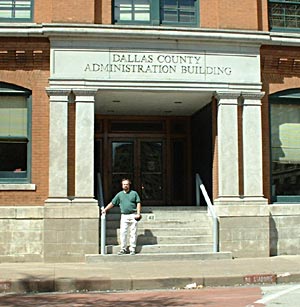
Me again... on the steps of the former Texas School Book Depository. This building is still used as an office building, except for the sixth floor, which houses the assassination museum. Knowing what happened here, working in this building has got to be a strange feeling, but I guess a daily routine would soon erase that.
Man,
I need to lose some weight.
In the surrounding area...
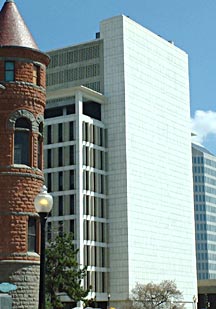
In this jail building near Dealey Plaza, Jack Ruby (killer of Lee Harvey Oswald) died from cancer in 1967... or so I was told by a guy hawking souvenir publications in the plaza.
Incidentally,
after I visited the JFK assassination site, I drove down and took a look
at the area where the Cotton Bowl is located. On the way back, I accidentally
saw the old Dallas Police Headquarters and the ramp leading from the street
to the basement where Oswald was killed by Jack Ruby.
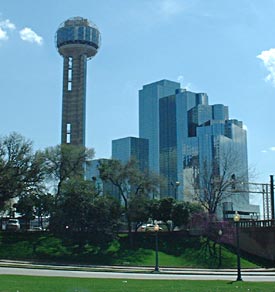
The
Hyatt Regency and Reunion Tower overlook Dealey Plaza.
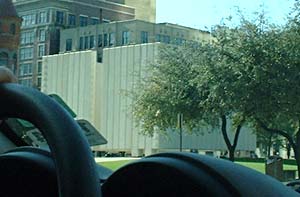
The
JFK Memorial, about a block north from Dealey Plaza.
To sum up, it was a fascinating visit to Dealey Plaza that finally put my curiosity to rest. To stand where history took place and to see for yourself images that you've only seen in books and movies was an unforgettable experience.
Who actually killed JFK? I have to side with the official Warren Commission version that Lee Harvey Oswald did it alone. Why did he do it? I've found the best explanation here. Does it even matter any more? Probably not. What's done is done and time goes on.
Back to The (almost) Daily Comment